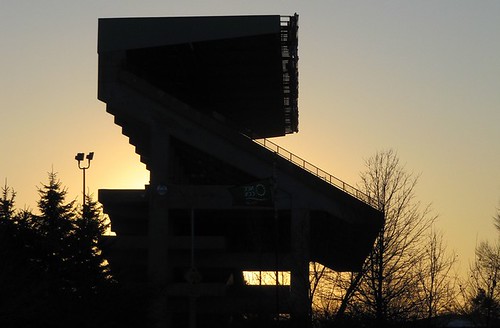
In a 15-9 vote last night Ottawa City Council approved the Lansdowne Live partnership. While Spacing Ottawa took no position on the redevelopment — our contributors and commenters were split on the issue — over the course of the debate and the public consultation process we ran strong arguments both in favour and opposed to the OSEG proposal, starting with an impassioned “pro” editorial on our very first day from Alain Miguelez, who called it a key city-building project and argued that:
There should be more people at Lansdowne. There should be more action. As a city we should rejoice about any plan that accomplishes this. When you sweep aside all the cobwebs of the rhetoric and entrenched positions, we as a city should want Lansdowne to be a public space and people place designed around sports, markets, commerce, and green space. And that, in my view, is what would really make this redevelopment as a marker of our civic maturity.
Much less enamored with the proposal was Tim Lash, who turned his written response to a city survey into an excellent op-ed pointing out the shortcomings of the partnership with OSEG, which, he maintains, sees the city give far too much of the public realm away, with even the expense of developing the proposal itself being at the taxpayer’s risk. He called for a better process, taking the whole of the site into account:
Start with a clear unified public purpose or set of purposes for the Park as a whole; the design must be for the whole at once, based on a coherent and publicly accepted purpose, to avoid piecemeal fragmentation, and to achieve harmony of elements that nestle together or complement each other at different scales and with functions that flow together well….Do not privilege any private design that jumps the gun. Tell the developers to wait until the purpose and master plan are set, and ensure they know that any advance expenses at this time are at their own risk, not at the risk of Ottawa citizens, and will not prejudice open public decision on the whole.
As the editor of Spacing Ottawa I’ve spoken with many readers and contributors about Lansdowne and I’ve observed a similar split in opinion again and again. Broadly speaking, once you leave the Glebe itself – where proximity makes its own argument– those who value a full spectrum of urban experience (above the details of who is in charge of what) are looking forward to the development; others who view public space as a vital asset of shared citizenship are deeply suspicious of a complex deal that ties governance to private interests for decades to come.
And then there is process. Many Spacing readers will be anxious about a vote that saw rural and suburban councilors come together to vote down the concerns of urban representatives on a debate that had significant consequences for a downtown neighbourhood. With the Lansdowne verdict impossible to ignore, there is a real risk that urban neighbourhoods will go into defensive mode, seeing themselves under permanent threat from the next council-supported Big Development, and fail to grasp the opportunities that intensification can bring.
Photo by Mike Gifford

5 comments
This is exactly the problem : suburban councilors with their suburban visions voting on downtown issues. Don’t even ask me what I think of the mayor…
S. 224 of the Municipal Act states that it is the role of council to consider the well-being of the municipality, not just the part that is their ward. The wards are just a means of dividing up the city.
The problem with the process wasn’t that non-urban councillors got a vote. It was that the revitalization should have been started by the city, with parameters set by the city and then driven by the city. It was not. The mess we find ourselves in now is a result of the project being proposed and driven by OSEG. The city needs to get control and if OSEG doesn’t like it, I am sure there will be other developers willing to do the development.
Julia – good points although I must clarify – at no point has anyone suggested in Spacing Ottawa that it is a problem “that non-urban councillors got a vote” on Lansdowne.
Also, I would quibble on your using “just” as in “the wards are just a means of dividing up the city”.
Wards *are* a means of dividing the city, of course, but they are clearly more than that as well. Clive Doucet would never pretend to be speaking for North Gower, for example, and equally Glen Brooks would not likely to be found chairing a commitee overseeing a community development plan for Centretown.
Evan… well yes, I agree with the ward thing – I was merely trying to make a point. But just because I am running in College Ward and hope to represent it, doesn’t mean I don’t know anything about the rest of the city. In fact, over the years, I have lived out near Burritts Rapids as well as downtown (Bronson and Gladstone). I am also educating myself on things like “smart growth” and I would have a real interest in any development, to see that it was being done properly and well. I wouldn’t take the lead if it wasn’t my ‘hood, but I might want to sit on the committee.
Found this video somebody took one spring weekend afternoon showing gridlock in the Glebe.
An excellent illustration of why Lansdowne Live won’t work.
http://www.youtube.com/watch?v=U_VtFa34jLk&feature=player_embedded